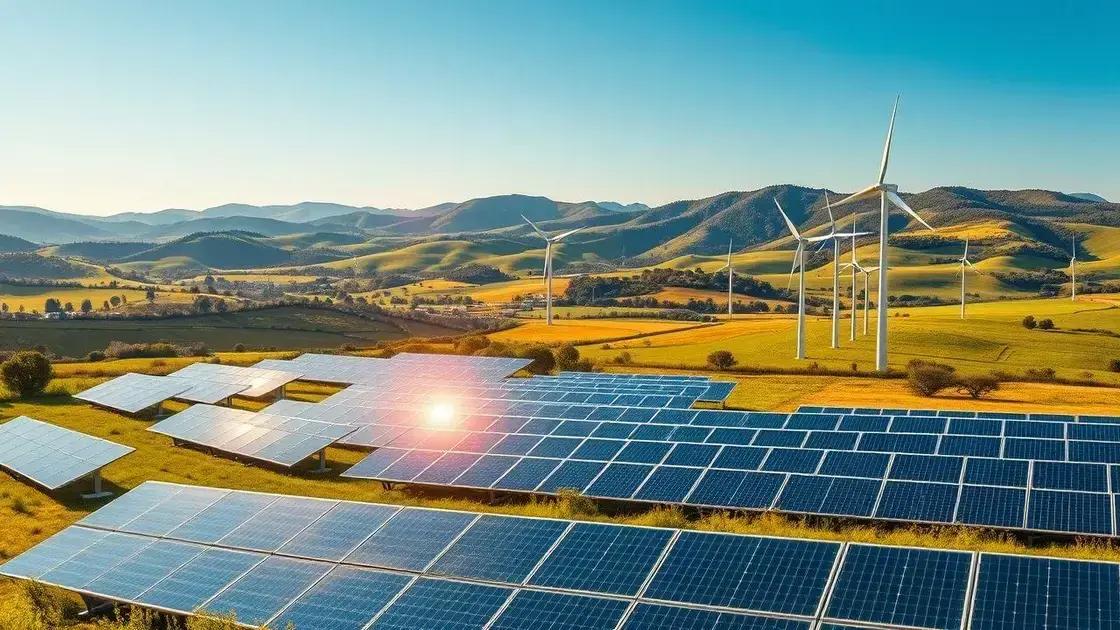Climate tech developments trends shaping our future

The latest climate tech developments focus on innovative renewable energy solutions, effective carbon management, and sustainable practices that businesses are adopting to combat climate change and maximize efficiency.
Climate tech developments trends are at the forefront of addressing our planet’s most pressing challenges. Have you ever wondered how these innovations can impact your daily life? Let’s dive into the trends reshaping our environment.
Latest innovations in climate tech
Recent innovations in climate tech have made waves across various industries. From green buildings to renewable energy, these advancements are reshaping our world. Let’s delve into some of the latest technologies that are making a substantial impact.
Advancements in Renewable Energy
Renewable energy sources like solar and wind power have seen remarkable improvements in efficiency. Technologies such as bifacial solar panels and larger wind turbines are driving this change. These innovations not only increase energy output but also reduce costs.
- Bifacial solar panels capture sunlight on both sides, enhancing energy generation.
- Offshore wind farms provide more consistent winds, leading to higher energy production.
- Energy storage systems, like advanced batteries, ensure power availability even during low production periods.
In addition, innovations in energy efficiency are crucial. Smart grids and appliances adjust energy use based on demand, which helps in managing resources effectively. These systems provide valuable data to consumers and utilities, encouraging energy saving.
Carbon Capture and Storage Technologies
Another significant innovation is in carbon capture and storage (CCS) technology. By capturing carbon dioxide emissions from sources like power plants, CCS helps mitigate climate change. Innovative methods, such as direct air capture, are gaining traction, allowing for the removal of CO2 directly from the atmosphere.
Moreover, some companies are utilizing captured carbon for creating products. This includes turning carbon into fuels or even building materials. The potential for circular carbon economies is an exciting prospect for future sustainability.
As we explore these advancements, it’s clear that the landscape of climate tech is rapidly evolving. Investors and governments are increasingly backing projects focused on sustainability, propelling further research and development in this vital field.
Impact of climate policies on technology

The impact of climate policies on technology is profound and far-reaching. As governments around the globe implement regulations, innovations emerge to meet new standards. This connection between policy and technology drives many advancements we see today.
Driving Innovation through Regulation
Climate policies encourage businesses to adopt greener technologies. For example, mandates for reduced emissions lead to the development of electric vehicles and clean energy systems. Companies, in their quest to comply with regulations, often venture into new territory, resulting in breakthroughs.
- Government incentives for renewable energy projects foster growth in solar and wind technology.
- Emissions regulations push industries to innovate in carbon capture and energy efficiency.
- Funding programs support research in sustainable materials and technologies.
These developments not only help companies comply with laws but also benefit consumers. For instance, cleaner technologies often lead to lower operating costs and improved air quality. While businesses strive for compliance, they also create competitive advantages through technological advancements.
Global Cooperation and Technological Exchange
International climate agreements play a significant role in shaping technology trends. Countries must collaborate, sharing ideas and innovations without borders. Agreements like the Paris Accord motivate nations to adopt and spread green technologies. This collaborative spirit fosters innovations that benefit everyone.
As nations commit to reducing their carbon footprints, technology becomes a key player. Each country may develop unique solutions, enhancing the global pool of knowledge. This exchange leads to improvements in environmental management and sustainability practices.
The importance of climate policies extends beyond legal compliance; they help shape a sustainable future where technology and the environment work hand in hand. The synergy between policy and technology creates endless possibilities for future advancements.
How businesses are adopting climate tech
More and more businesses are recognizing the importance of adopting climate tech solutions. As environmental awareness grows, companies are taking steps to integrate sustainable practices into their operations. This shift is not just good for the planet; it can also lead to significant cost savings and new market opportunities.
Integrating Sustainable Practices
Businesses are implementing various strategies to reduce their carbon footprints. Many are investing in energy-efficient equipment and renewable energy sources. This shift often leads to lower energy costs.
- Energy-efficient appliances are being used to cut down energy consumption.
- Solar panels are being widely adopted, allowing businesses to generate their own power.
- Electric vehicles are replacing traditional delivery fleets, reducing emissions significantly.
Moreover, companies are increasingly focused on reducing waste. Some businesses are adopting circular economy principles, aiming to recycle materials and minimize waste throughout their production processes. This not only benefits the environment but also can enhance brand loyalty among eco-conscious consumers.
Innovating with Technology
Many businesses are leveraging new technologies to innovate and enhance their sustainability efforts. Innovations in artificial intelligence and data analytics allow companies to optimize their energy use and improve operational efficiency. For instance, AI can predict energy demand, enabling businesses to adjust their use accordingly.
Collaborations between companies, startups, and research institutions are also fostering the development of new climate tech solutions. Through these partnerships, businesses can access cutting-edge technologies and expertise, helping them navigate the complex landscape of sustainability.
The movement toward adopting climate tech is not just a trend; it is becoming a necessity for businesses aiming to thrive. By embracing sustainable practices and innovative technologies, they set themselves up for future success while contributing to a healthier planet.
Future predictions for climate technology

Future predictions for climate technology suggest significant and transformative changes are on the horizon. As research and development continue to accelerate, we can anticipate a range of innovative solutions that will address environmental challenges.
Advancements in Renewable Energy
The renewable energy sector is set to expand dramatically. Innovations such as advanced solar cells and increased wind turbine efficiency will play crucial roles in this growth. Companies are investing heavily in new technology to maximize energy output.
- Perovskite solar cells are expected to revolutionize solar power with their efficiency and low production costs.
- Floating wind farms will harness wind energy in deeper waters, potentially increasing capacity significantly.
- Hydrogen fuel cells may become a mainstream energy source, serving both vehicles and industry.
As these technologies mature, we will likely see an even greater integration of renewable energy into everyday life. Energy storage solutions, such as advanced batteries, will help balance supply and demand, making renewable energy more reliable.
Innovations in Carbon Management
Another area of growth will be in carbon management technologies. With increasing urgency to tackle climate change, methods for capturing and utilizing carbon emissions will improve. These innovations will not only reduce greenhouse gases but also create new economic opportunities.
Technologies such as direct air capture and carbon utilization techniques will continue to evolve. Businesses will find ways to profit from what was previously considered waste, creating a circular economy focused on sustainability.
Looking ahead, climate tech will not just be about mitigation but also adaptation. Technologies that help communities prepare for climate impacts will gain importance. This includes smart infrastructure and agriculture solutions designed for changing environments.
Overall, as climate technology advances, the possibilities for a sustainable future grow. The innovations we anticipate will play vital roles in shaping not only our environment but also our economy and society.
In conclusion, the future of climate technology holds great promise for addressing the environmental challenges we face today. As innovations in renewable energy and carbon management continue to evolve, businesses and communities will increasingly adopt solutions that promote sustainability. Together, these developments not only aim to mitigate climate change but also foster economic growth and resilience. As we look forward, the commitment to enhancing climate tech will be essential for a healthier planet and a brighter future.
FAQ – Frequently Asked Questions about Climate Technology
What is climate technology?
Climate technology refers to innovations and solutions designed to address climate change and its impacts, focusing on sustainability and reducing environmental footprints.
How are businesses adopting climate technology?
Businesses are integrating climate tech by investing in renewable energy, energy-efficient systems, and sustainable practices to reduce their carbon footprints and operational costs.
What role does government policy play in climate tech?
Government policies are crucial as they drive innovation and investment in climate tech by setting regulations, incentives, and funding for sustainable initiatives.
What are the future predictions for climate technology?
Future predictions include significant advancements in renewable energy technologies, increased carbon management solutions, and enhanced collaboration globally to tackle climate change.






